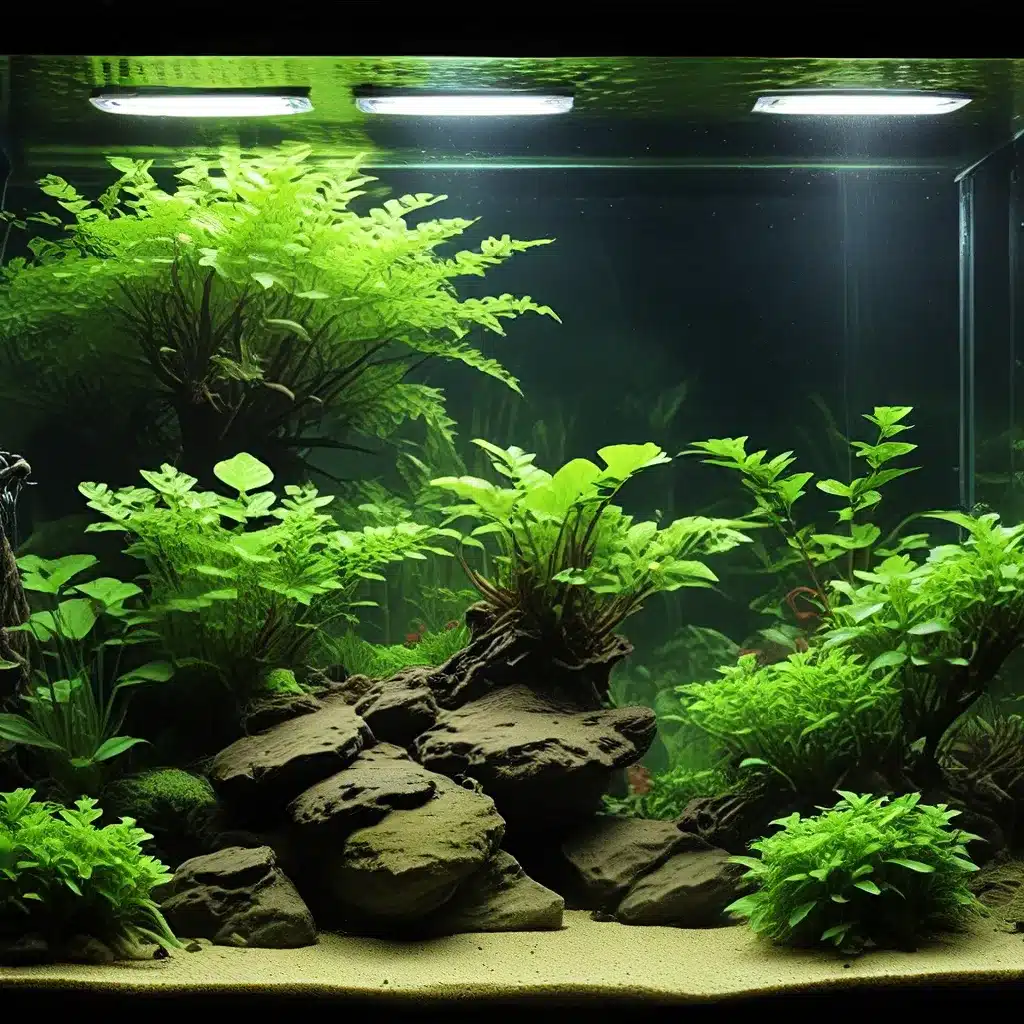
In the captivating world of aquarium keeping, the role of lighting cannot be overstated. As aquarists, we strive to create vibrant, thriving underwater ecosystems, and the key to achieving this lies in understanding the intricate relationship between aquarium lighting and plant photosynthesis.
The Importance of Proper Lighting
Aquarium lighting is the foundation upon which a healthy, well-balanced planted tank is built. Just as the sun’s rays nourish terrestrial plants, the right lighting conditions are essential for the photosynthetic processes that sustain aquatic flora. Photosynthesis, the process by which plants convert light energy into chemical energy, is the lifeblood of a planted aquarium, driving the growth and vitality of your aquatic vegetation.
When the lighting in your tank is not properly calibrated, it can have a profound impact on the overall health and aesthetic appeal of your aquatic plants. Insufficient lighting can lead to stunted growth, algae outbreaks, and a dull, lifeless appearance, while excessive or imbalanced lighting can cause a host of other issues, such as plant bleaching, rapid algae proliferation, and disrupted nutrient uptake.
Understanding the Spectrum of Aquarium Lighting
Aquarium lighting encompasses a wide range of wavelengths and color temperatures, each playing a crucial role in the photosynthetic process and the overall development of your aquatic plants. Photosynthetically Active Radiation (PAR), the specific range of light wavelengths that plants can utilize for photosynthesis, is a key consideration when selecting the right lighting for your planted tank.
King Aquarium recommends focusing on the red and blue wavelengths of the light spectrum, as these are the primary drivers of photosynthesis in aquatic plants. The red wavelengths, typically ranging from 600 to 700 nanometers (nm), are essential for promoting stem elongation, leaf development, and overall plant growth. Conversely, the blue wavelengths, spanning from 400 to 500 nm, are crucial for stimulating chlorophyll production, root development, and the overall health and vigor of your aquatic vegetation.
By carefully balancing the red and blue wavelengths, you can create a lighting spectrum that closely mimics the natural environment, providing your plants with the optimal conditions for thriving and flourishing.
Calculating the Right Lighting Intensity
Determining the appropriate lighting intensity for your planted tank is a crucial step in ensuring the success of your aquascaping endeavors. This parameter, often measured in Photosynthetically Active Radiation (PAR), represents the amount of light energy available for your plants to utilize during photosynthesis.
The ideal PAR levels can vary depending on the specific plant species, tank size, and depth. As a general guideline, Reef2Reef suggests targeting a PAR range of 20-60 for low-light plants, 40-80 for medium-light plants, and 60-100 for high-light plants. By carefully monitoring and adjusting the lighting intensity in your tank, you can create the perfect environment for your aquatic vegetation to thrive.
Lighting Strategies for Aquascaping
When it comes to aquascaping, the strategic placement and selection of aquarium lighting can greatly enhance the aesthetic appeal and visual depth of your underwater garden. By leveraging different lighting techniques, you can create captivating visual effects, highlight specific plant species, and accentuate the natural contours of your aquascape.
One popular approach is the use of spot lighting, where you strategically position high-intensity LED lights to draw the eye to specific focal points in your tank, such as vibrant plant clusters or striking hardscapes. This technique can help create a sense of depth and drama, adding visual interest to your aquarium.
Another effective strategy is layered lighting, which involves utilizing a combination of LED fixtures at different heights and intensities to create depth and texture. This approach can be particularly useful in taller aquariums, where you can use low-light fixtures for the background and high-light fixtures for the foreground, creating a visually striking and harmonious aquascape.
Maintaining Optimal Lighting Conditions
Ensuring the long-term success of your planted tank requires diligent maintenance and monitoring of your aquarium lighting system. Regular light cycle adjustments, fixture cleaning, and bulb replacements are essential to maintaining the optimal lighting conditions for your aquatic plants.
It’s also important to consider the photoperiod, or the duration of light exposure your plants receive each day. Aquatic plants, much like their terrestrial counterparts, require a balance of light and dark periods to thrive. Aim for a photoperiod of 8-12 hours, adjusting as needed based on the specific requirements of your plant species and the observed growth patterns in your tank.
By staying vigilant and proactive in managing your aquarium lighting, you can create a vibrant, thriving underwater ecosystem that captivates both you and your aquatic inhabitants.
Conclusion
The role of aquarium lighting in the success of a planted tank cannot be overstated. By understanding the principles of photosynthesis, light spectrum, and lighting intensity, you can unlock the true potential of your aquatic vegetation, fostering a lush, healthy, and visually stunning underwater oasis.
Whether you’re a seasoned aquarist or a newcomer to the hobby, mastering the art of aquarium lighting is a crucial step in your journey towards creating a captivating and sustainable planted tank. By following the insights and strategies outlined in this article, you’ll be well on your way to unveiling the wonders of aquarium lighting and, in turn, cultivating a thriving aquatic paradise that will delight and inspire you for years to come.

